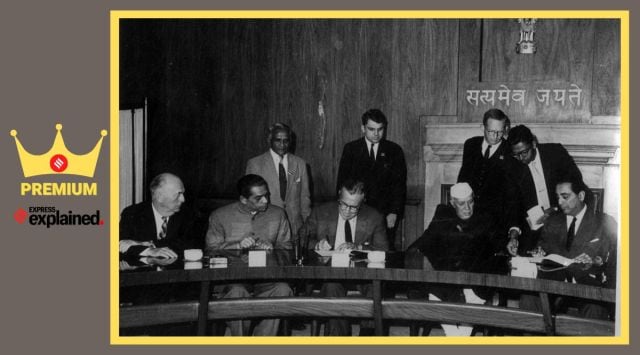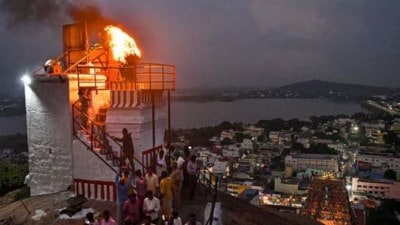“Mr President, I feel I have blood on my hands,” J Robert Oppenheimer told United States President Harry S Truman during a meeting at the White House in October 1945, according to American Prometheus, the 2005 book on which Christopher Nolan’s biopic Oppenheimer is based.
Oppenheimer, director of the Los Alamos Laboratory that designed the bombs that were dropped on Hiroshima and Nagasaki, was referring to the tens of thousands of victims of the bombing. Truman dismissed Oppenheimer as a “crybaby”, according to the film.

The nuclear ‘chain reaction’
Oppenheimer believed that the atomic bomb, once it had revealed its terrifying power, would “end all wars” of the future. A scene in the film captures the eminent physicist’s moment of naïveté, in which, after the success of the Trinity test, he continues to believe that scientists would have control over the weapon — he asks Maj. Gen Leslie Groves of the US Army if he can travel to Washington DC where the decision on using the bomb would be made.
As it happened, the atomic bombing of Japan in August 1945 was followed immediately afterwards by the nuclear arms race between the US and the USSR, which defined the decades of the Cold War.
In July 1953, a year before he lost his security clearance after being accused of having communist and Soviet sympathies, Oppenheimer wrote: “Atomic weapons are not just one element of an arsenal that we hope may deter the Soviet Government, or just one of the means we think of for putting an end to a war, once started. It is, perhaps, almost the only military measure that anyone has in mind to prevent, let us say, a great battle in Europe from being a continuing, agonizing, large-scale Korea. It is the only military instrument which brings the Soviet Union and the United States into contact — a most uncomfortable and dangerous contact — with one another.” (‘Atomic Weapons and American Policy’, Foreign Affairs)
Seventy years on, even after the original Cold War has ended, the world faces the challenge of this “most uncomfortable and dangerous contact” as President Vladimir Putin employs dangerous nuclear rhetoric in the context of the war in Ukraine. The Indian government too has expressed concern over the sabre-rattling; Prime Minister Narendra Modi has directly reminded President Putin that “this is not the era of war”.
India’s n-story: the early years
In the years after Independence, Prime Minister Jawaharlal Nehru followed a dual intent strategy on “nuclear power”. He made it clear in 1950 that while he was against the atom bomb, the call for a nuclear-free world must come from a position of strength, not weakness.
Story continues below this ad
Nehru entrusted Dr Homi J Bhabha with leading India’s nuclear programme — to develop the capability to use nuclear energy for peaceful purposes, but to retain the capacity to develop a weapon if the need arose. The Indian political leadership was always aware that this meant a wink and a nod for India’s strategic weapons programme.
India’s external environment became more challenging after the defeat to China in 1962. Two years later, in 1964, China tested a nuclear weapon. By this time, all the permanent members of the United Nations Security Council had tested nuclear weapons — after the US in 1945, the USSR tested in 1949, the UK in 1952, and France in 1960.
In his book India’s Nuclear Bomb: The Impact on Global Proliferation (1999), George Perkovich wrote: “Bhabha was consciously developing nuclear weapon capabilities prior to the emergence of a Chinese nuclear threat… Main motivations for India’s initial plans to acquire the means to produce nuclear explosives had more to do with Bhabha’s and Nehru’s beliefs that nuclear technology offered India a shortcut to modernity and major power status. By mastering nuclear science and technology — and in the process, acquiring the potential to make nuclear weapons — India could transcend its recent colonial past.”
From Indira to Vajpayee
India’s first nuclear test in 1974, when Indira Gandhi was Prime Minister, demonstrated its capability to produce nuclear weapons, but international opprobrium and resistance from within led to a slowing of the process to build and deploy a full nuclear arsenal.
Story continues below this ad
The push to develop nuclear weapons came from an unlikely source, a decade later. In her new book How Prime Ministers Decide (2023), Neerja Chowdhury, Contributing Editor at The Indian Express, writes about a conversation between President Ronald Reagan and Prime Minister Rajiv Gandhi.
“When they met in October 1985, Reagan told Rajiv Gandhi, ‘Pakistan has already made a bomb.’ When Rajiv started talking about disarmament, the US President cut him short, ‘Don’t talk theory, think of your own protection’,” Chowdhury has written.
Around this time, strategists such as K Subrahmanyam and Army Chief General K Sundarji had also started advocating for nuclear weapons. Prof Rajesh Rajagopalan of JNU’s School of International Studies wrote in a 2009 paper on India’s nuclear policy:
“Both Sundarji and Subrahmanyam argued that the kind of bloated nuclear arsenals that the US and the Soviet Union developed during the Cold War were unnecessary and wasteful. Nuclear deterrence could be had at far cheaper cost, with a relatively small arsenal… What they were suggesting was a view of nuclear weapons that emphasized its political rather than military utility, its deterrence rather than war-fighting capability.”
Story continues below this ad
In 1989, Rajiv gave Defence Secretary Naresh Chandra approval to develop the bomb. Rajiv lost power in the election of that year and was assassinated in 1991, but successive governments continued to support the programme.
Prime Minister Atal Bihari Vajpayee saw the nuclear tests of 1998, codenamed Operation Shakti, as the “beginning of the rise of a strong and self-confident India”. The tests were a response to the threat posed by Beijing, Vajpayee told President Bill Clinton.
“We have an overt nuclear weapon state on our borders, a state which committed armed aggression against India in 1962. Although our relations with that country have improved in the last decade or so, an atmosphere of distrust persists mainly due to the unresolved border problem,” Vajpayee wrote to Clinton.
The present and future
Following Pokhran-II, the Indian leadership exploited the political utility of its action — the tests, which once again attracted international criticism and sanctions, also created political space for, and gave strategic autonomy to India’s decision-making.
Story continues below this ad
The talks between Jaswant Singh and Strobe Talbott laid the foundation for the Next Steps in the India-US Strategic Partnership, and led to the Indo-US nuclear deal — which paved the way for the strategic partnership that now involves high-end technology cooperation from defence to artificial intelligence.
India’s nuclear weapons have so far served well the purpose of deterrence that Oppenheimer and the team around him discussed in the 1940s. During the Balakot surgical strike of 2019, Indian military jets crossed the border into Pakistan, but the battle remained in the air, and conventional weapons were used.
Ahead of the G7 summit in Hiroshima this May, Japan’s Prime Minister Fumio Kishida spoke of his desire to use the meeting to “send out a strong message” about the need for a world without nuclear weapons. As the chair of G20 this year, India — which was invited to Hiroshima — has both the leverage and the moral stature to take the lead in working with the international community to reduce the risk of use of nuclear weapons. It must ensure it uses this strength — at least so there is no “blood on its hands”, as Oppenheimer said.








































